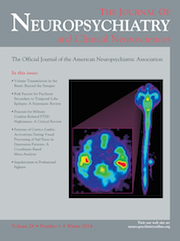A Case of Late-Onset Bipolar Disorder With Severely Abnormal Behavior and Neuroimaging Observations Very Similar to Those of Frontotemporal Dementia
To the Editor: Frontotemporal dementia (FTD) is mainly characterized by neuropsychiatric symptoms, usually preceding cognitive impairment, and an early impairment of executive functions, with relatively preserved memory and visuospatial skills.1 There have thus been some case reports of FTD that is initially diagnosed as schizophrenia or bipolar disorders (BP).2 We herein report a case of late-onset BP that was initially diagnosed as major depressive disorder and was temporarily diagnosed as FTD because of severely abnormal behaviors and neuroimaging observations that were very similar to those of FTD.
Case Report
The patient was a 52-year-old-man. There was no definite family or past history of mental or neurological diseases. At 42 years of age, he began to show depressive symptoms, including depressive mood and psychomotor retardation. At age 46, he gradually began to show hypomanic symptoms, including hyperactivity and hypersexual talk. He appeared stark naked in an orthopedic hospital and was thus admitted to our hospital at age 47. He sometimes stripped himself to the waist and masturbated in front of others. Valproate (800 mg/day) was immediately prescribed, instead of clomipramine (225 mg/day). Thereafter, his abnormal behaviors were gradually ameliorated; however, he became apathetic and had difficulty in doing his daily activities. Medical examinations, including complete blood count, liver, renal and thyroid function tests, and electroencephalography showed no definite abnormalities. Neuroimaging observations (SPECT) showed predominant frontal hypoperfusion, as well as predominant frontal brain atrophy shown by MRI. A Wisconsin Card-Sorting Test also demonstrated frontal lobe hypofunction. He was thus diagnosed with FTD. However, lithium (600 mg/day) was prescribed instead of valproate because of the possible diagnosis of bipolar disorder. Thereafter, his apathetic symptoms were gradually ameliorated, and he was discharged from our hospital about 22 months after the admission. The abnormalities shown by neuroimaging studies described above were ameliorated after the lithium treatment for BP for about 2 years. He has been euthymic for about 4 years, until the present time.
Discussion
Woolley et al. demonstrated that patients with FTD were more likely to initially present to a psychiatrist than to a neurologist and often receive erroneous psychiatric diagnoses before FTD was correctly diagnosed.2,3 On the contrary, in the present case, the diagnosis of FTD was temporarily made because of severely abnormal behaviors and neuroimaging observations. To the best of our knowledge, there have been no reports describing late-onset BP preceding the diagnosis of FTD. Ng et al. suggested that the clinician should keep bipolar spectrum disorders in the differential diagnosis of late-onset affective dysregulation in the setting of dementia.4 Mendez et al. have demonstrated that consensus criteria and neuropsychological measures lacked sensitivity for FTD and that clinical diagnosis of FTD needs to combine neuropsychiatric features with SPECT or PET findings.5 We clinicians should bear the present case in mind and diagnose carefully in the clinical setting of dementia.
1 : Functional neuroimaging and presenting psychiatric features in frontotemporal dementia. J Neurol Neurosurg Psychiatry 2006; 77:4–7Crossref, Medline, Google Scholar
2 : The diagnostic challenge of psychiatric symptoms in neurodegenerative disease: rates of and risk factors for prior psychiatric diagnosis in patients with early neurodegenerative disease. J Clin Psychiatry 2011; 72:126–133Crossref, Medline, Google Scholar
3 : Frontotemporal dementia and mania. Am J Psychiatry 2007; 164:1811–1816Crossref, Medline, Google Scholar
4 : A case series on the hypothesized connection between dementia and bipolar spectrum disorders: bipolar type VI? J Affect Disord 2008; 107:307–315Crossref, Medline, Google Scholar
5 : Accuracy of the clinical evaluation for frontotemporal dementia. Arch Neurol 2007; 64:830–835Crossref, Medline, Google Scholar



